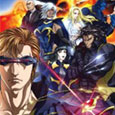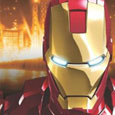Warner Home Video (June 3, 2003), 1 disc set, 88 mins plus supplements, 2.35:1 original anamorphic widescreen ratio, English and Japanese Dolby Digital 5.1 Surround, Rated PG-13, Retail: $14.98
Storyboard:
This collection of nine shorts gives a deeper view into the world of The Matrix from new, original points-of-view. Some of Japan’s top animators and directors give their own take on The Matrix universe revealing and adding some great new dimensions to this fascinating film franchise. The shorts include: Kid’s Story, Final Flight Of The Osiris, A Detective Story, The Second Renaissance Part I, The Second Renaissance Part II, World Record, Beyond, Matriculated, and Program.
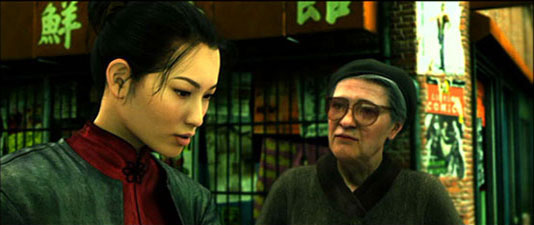
The Sweatbox Review:
I remember clearly when I first watched the first Matrix movie back in 1999. I went to the theatres with one of my best friends and we were very excited to see this new sci-fi flick that everyone said was excellent. By the end of the movie, we were convinced that it was one of the best sci-fi action flicks of all time (we were also convinced the roof of the movie theatre moved in a matrix-like way). Looking back, we know that The Matrix was a landmark motion picture that redefined the way action movies were made. The bullet speed camera movements, martial art techniques, and fashion used in the movie have been imitated in everything from Shrek to Scary Movie to countless television shows. It really has become an integral part of pop culture.
Few, however, know much about the origins and influences that inspired the Wachowski brothers to make the movie. They have cited numerous sources, but one of the main sources has been anime cartoons. Personally, my anime knowledge consists of Akira, Grave of the Fireflies, Perfect Blue, and Spirited Away, so it’s quite limited. However, with just that little, I think I have already surpassed the average North American’s knowledge of anime, which might not extend beyond Pokemon or Yugi-oh. Anime has, for many years, been a niche market in North America. In its native Japan, where this unique form of animation originated, it is highly successful. While in America, and much of the west, cartoons are seen as children’s movies, there is no such discrimination in Japan where the highest grossing movie ever is of Spirited Away.

During the premiere of The Matrix in Japan, the Wachowski brothers requested to tour the various anime studios. They later met with several directors and came up with the idea of having a series of shorts inspired by the world of the movie. The results were nine shorts, of various lengths, made by some of Japan’s greatest directors and artists. Each director brought their own style of filmmaking to the project, with a unique story and look for each short. The stories explore the world of the matrix, the real world, and even some of the characters in the movie. It explores the same themes of freeing one’s mind, embracing one’s destiny, loyalty, love, and humanity in its good and not-so-good forms. Of course, it also features spectacular visuals and heart-pumping action.
Of the nine films, the only one that has already been theatrically released is Final Flight Of The Osiris, which premiered in theatres last March in front of Dreamcatcher. The director, Andy Jones, who previously worked on Final Fantasy: The Spirits Within, borrows the technological advances made on that film to produce a stunning short. The movie starts out with an incredibly intense (in more ways than one) scene of a sword fight between a man and a woman. We soon find out, after moments of swords sending clothing into the air, that they are in a training program, and that they’re crewmembers of the human ship Osiris. Their program is cut short when they make a discovery that can change the course of the fight against the Matrix, and they must warn the others. However, an army of robot sentinels is chasing them and they have very little time. This short is actually the introduction to the new videogame that just came out and it is interesting to see how this might tie into the movie as well.
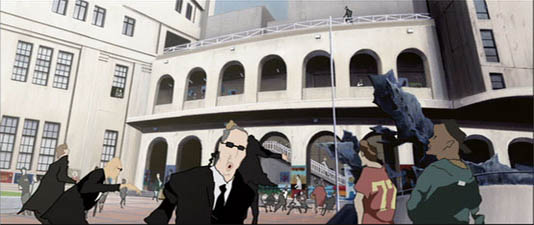
The second and third shorts are The Second Renaissance Parts I And II, respectively. This two-part short, directed by famous Japanese director Mahiro Maeda (director of Blue Submarine 6 TV show, and animator for Laputa: Castle In The Sky and Neon Genesis: Evangellion) deals with the origins of the Matrix and the robot revolution. For those of you not familiar with the movie (are there any of you out there?), robots have taken control of the Earth, and after a huge fight, they won and they now use our bodies for energy, while we live our lives in a virtual world. The two shorts, with a unique blend of traditional and CGI anime, chronicle the story from the first AI rebellion to Operation Dark Storm where the skies were darkened. There are various shots of robots being brutally tortured and destroyed, as well as graphic scenes of human violence. The short actually takes place within the Zion virtual library (represented by a Mandala) where the information is gathered in a series of newsreels and narrations. There’s not much to give away in this story, but it does serve as an interesting background for the movie. Fans of The Matrix comics may recognize some character designs in the story since the director used some of the same designs. While watching this film, I even began to sympathize with the machines as they fought for freedom. The director manages to humanize the machine as they reflect the good aspects of humanity while humans reflect the bad, finally leading the robots to use humanity’s darker side. It shows the evolution from humanoid robots that want to resemble humans out of respect, to very ruthless, inhuman robots by the end.
Kid’s Story, is one of the most visually creative films, and all of this is the creation of the talented director Shinichiro Watanabe (of Cowboy Bebop fame) who decided to try something different in the style. The story is actually from the Wachowski Brothers, but Watanabe added some new themes and content to the story. With this short, the director used a series of rough sketches to convey the emotions and themes in the scenes. This is done through a two-cell process, one with colors, and one with the rough sketches. The story is about a young boy who begins to philosophize about the difference between his dreams and reality. He manages to feel the power of the Matrix and begins to seek for the answer to everything. At school, his cell phone goes off and someone tells him to run because they have found him. Outside, the agents are beginning to enter the school to apprehend the young boy. What is so great about this story is not only its great visual aspect which sometimes reminded me of Waking Life, but also of the way the director handled mortality inside the Matrix. This is a theme that was not really talked about in the film, which focused more on the “free” characters, but not on those trapped within. It also deals with a different way a person can “free their mind.”
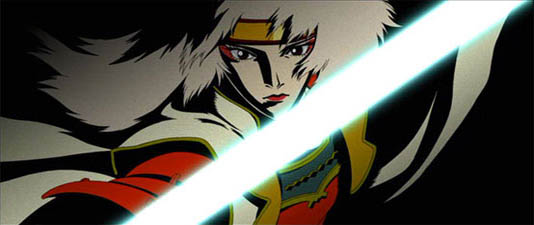
Program is perhaps the cartoon that visually holds the most traditional anime style, from the character designs, to the action, and the Japanese setting. There are rich colors used, specially red and widespread use of blacks and greys. With the designs, director Yoshiaki Kawajiri (Wicked City, Ninja Scrolls, and Vampire Hunter D: Bloodlust) wanted to evoke the image of ancient Japanese scroll designs. This one also takes place within a training program set in medieval Japan when Samurai ruled the land. In the story, a young woman named Cis is attacked by three horsemen on a field, and then she is challenged by her partner, Duo, to a friendly match in the program. What she does not know is that her partner is thinking about returning to the Matrix and turning his back on the team. He asks her to join him so that they can be together living a normal life. She now faces the difficult decision of turning back on the man she loves, or the truth that she has chased after for years. This is probably the most emotional film, and we follow the main character through the phases in her decision process. She is faced with a difficult dilemma and she has to make a quick decision, all in a virtual, but realistic, world.
The sixth film, World Record, story-wise, is the most unique, since it deals with the Matrix in the world of professional sports. It is about an athlete named Dan who has his eyes set on breaking his own world record on the 100-meter dash. A narrator quickly tells us that there is more than one way a person has achieved knowledge of the Matrix and its existence, and that this racer is about to find out for himself. However, the racer is not alone as there are agents that are closely monitoring his mind’s strange activity during the race. They are set on preventing him from breaking the record which could lead him to see, and free himself from, the Matrix. The character designs in this anime film are very unique, and they have a modern edge to them. Young director Takeshi Koike, uses dark shadows for the characters that usually have disproportionate body parts.

My favorite film is Beyond because it deals with the world inside of the Matrix that we can understand and now see it remembering that the matrix exists. It is about a young girl who loses her cat. When looking for her cat, she encounters a group of young children who say that the cat was seen entering the old haunted house. When they reach the house, they begin to witness strange events that they cannot explain. They see rain when there are no clouds in the sky, levitating objects, feathers that turn into doves, dogs that change colors and doors that lead nowhere. All of this happens as agents are quickly trying to reach the scene of a severe malfunction of the matrix, right at the site where the haunted house is located. I guess I this one is my favorite because it feels closer to home. We have all heard about haunted houses and supernatural events, and in the world where the Matrix exists, it would make sense to say it’s a malfunction. I also love it because the girl in the story knows something is strange, but she is content in exploring the beautiful anomalies of the house. She is content to live inside the Matrix and does not even think about leaving. Director Koji Morimoto, who was an animation supervisor for Akira and who previously directed Robot Carnival, does an excellent job in this film.

The next film, A Detective Story, is a noirish story that is filmed in black and white animation. Once again, director Shinichiro Watanabe manages to tell a creative story using a unique style. In this short he blends live action shots with the animation to tell a dark detective story. This film deals with the government’s attempts to find the famous hacker Trinity. The detective looks back at the old investigations on Trinity and finds out that the other detectives are either dead or insane. Using Alice in Wonderland clues and computer chat rooms, he finally manages to get in contact with someone that wants to meet him. Of course, the Matrix’s own agents are after Trinity.
The last story takes a different look at the battle between men and robots. Matriculated begins with a young woman standing on a beach with a monkey waiting for something. We soon learn that she is luring sentinels into a secret hideaway. What happens once the robots reach the location is what makes it different since the humans use robots to fight the robots. They begin to “re-educate” the robots to fight for them, but they let them choose the life they offer, even though it is virtual. It gets complicated, but it is a very interesting concept for the fight against robots. Do robots have free will? Do they have desires and, with it feelings? This film is directed by Aeon Flux creator, Peter Chung who brings some of his unique character designs to the story.

Is This Thing Loaded?
I was pleasantly surprised to find many special features on this disc. I can tell that the producers care about the release, and I’m also happy that Warner also supported it. Included in the special features are audio commentaries, a documentary on anime, and a making-of The Animatrix.
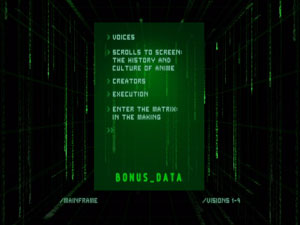
Audio commentaries are found in the “Voices” area of the Special Features. The commentaries are found for four different films including The Second Renaissance Parts I and II, Program, and World Record. In the commentaries, the directors and producers talk about the making of the film, their style, and what they wanted to convey to the audience. Some of the commentaries drag, but the makers are always speaking, which is nice. The problem sometimes is that they keep narrating the story instead of talking more about what they did. This happens particularly in The Second Renaissance, but it is interesting to see what the maker was thinking when he made the film. Program and World Record have better commentaries with the makers talking more about the design of the characters as well as their interpretations of the subject. Note that these commentaries are in Japanese with English subtitles.

Scrolls to the Screen: The History and Culture of Anime is a twenty-two minute documentary that narrates the origins of the genre from the scrolls of medieval Japan to the post-WWII era, to present day. I had never thought about what an anime movie was made up of. It is interesting to see the different characteristics, and the documentary features interesting commentaries by many Japanese pop culture scholars, as well as anime directors. It goes from the origins of anime after the war to modern day anime, exploring both television and film. It also discusses some of the influences of anime in The Matrix.
Execution talks about the making of The Animatrix films. You can either watch these individually or you can select the Play All function. In these documentaries, the creators and producers talk about what they were looking for, the idea for The Animatrix, and how they selected the different directors. When looking at each individual film, they talk about the background of the different directors and why they were chosen. It is also interesting to see the different techniques the directors used in their cartoons and what they were trying to achieve.

Besides these documentaries, there is a short commercial entitled “Enter the Matrix: In the Making” about the making of the Enter the Matrix videogame. This is where you learn that The Final Flight of the Osiris is the intro to the story of the video game. There are also bios for each of the makers in the “Creators” area.
Case Study:
The DVD is in the standard Warner Bros. snapper case. It’s not my favorite, but at least the cover art is nice to look at.
Ink And Paint:
All films are presented in the 2.35:1 widescreen aspect ratio. The image is incredibly clear and I found no problems. I am sure that the transfer is digital, especially in Final Flight Of The Osiris, and all of the films look impeccable. The feature itself runs about eighty-nine minutes with the special features totaling up around seventy-eight minutes.
Note that this has not been rated, but since The Matrix is an R-rated movie, please remember that this is not for children. Besides containing some violent, and sometimes grotesque, images, there is also some adult language, sensuality, and an apparent teenage suicide.

Scratch Tracks:
The films are available in English and Japanese Dolby Digital 5.1 audio tracks. The tracks come out very clear and are very intense during the many action sequences. I liked the sound in Final Flight Of The Osiris the best which could not be better. This is probably because they released it theatrically. I listened to most of the films in English and the dubbing is very good (although I think the films were intended to be in both English and Japanese anyways). There are English, French, and Spanish subtitles also available, besides the commentary tracks already mentioned.
Final Cut:
For fans of The Matrix who are excited about the new movie, this is just icing on the cake. The nine films included in this collection are great extensions of The Matrix universe and should appeal to fans of the series. For those that are not fans of The Matrix, I doubt that you’d be thinking about picking this up, although if you’re an anime fan, you might be interested. All of the shorts stay in the spirit of the original movie’s universe, and they are all executed by their directors with great creativity and artistic originality. The special features are also enjoyable and this all makes the DVD a great value.
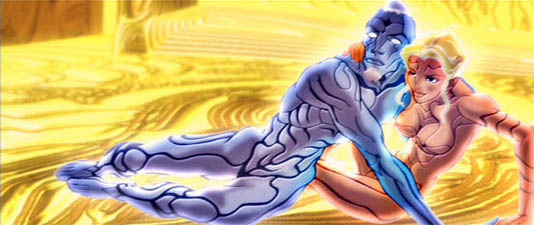
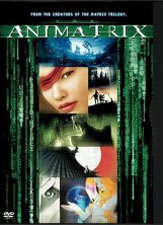 | ||
 |







